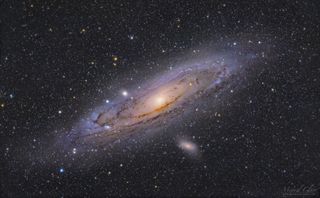Andromeda Galaxy Twinkles in a Colorful Sea of Stars (Photo)

Miguel Claro is a professional photographer, author and science communicator based in Lisbon, Portugal, who creates spectacular images of the night sky. As a European Southern Observatory Photo Ambassador and member of The World At Night and the official astrophotographer of the Dark Sky Alqueva Reserve, he specializes in astronomical "Skyscapes" that connect both Earth and night sky. Join Miguel here as he takes us through his photograph "The Colourful Spiral Galaxy of Andromeda."
Around the same time that the first human ancestors of the genus Homo roamed the Earth, light from the Milky Way's closest neighboring galaxy began its 2.5 million-year trek to our planet, creating the image we see today.
Homo, the genus that includes modern humans, is estimated to be between 1.5 and 2.5 million years old. Meanwhile, the Andromeda galaxy (M31) is 2.5 million light-years away from Earth. In the amount of time it took for that light to reach us, humans have evolved from the stone tool-wielding Homo habilis up to the point where we have the necessary technology to construct powerful telescopes, giving us the capability to observe, study, photograph and understand the wonders of the vast universe. [Andromeda Galaxy Photos: Amazing Pictures of M31]
Despite the astronomical distance, the Andromeda galaxy is the nearest spiral galaxy to our Milky Way. Measuring approximately 220,000 light-years across, Andromeda is the largest galaxy of the Local Group, a collection of gravitationally bound galactic neighbors that also contains the Milky Way, the Triangulum galaxy and about 30 other smaller galaxies.
This colorful scene shows the arms and core of Andromeda immersed in a sea of stars. The stars that surround the diffuse spiral shape are actually stars from our own galaxy, the Milky Way, visible in front of M31. While Andromeda's spiral shape is apparent in visible-light images, its galactic arms look more like rings in ultraviolet images from NASA's Galaxy Evolution Explorer spacecraft. Astronomers believe that this ring-like appearance may be evidence that Andromeda collided with its smaller neighboring elliptical galaxy M32 more than 200 million years ago. M32 is also visible as the bright, circular, diffuse shape on the left side of Andromeda's galactic core. M110, a dwarf elliptical galaxy visible below M31, is also a satellite of the Andromeda Galaxy.
To capture this image of the Andromeda Galaxy, I used a Takahashi FSQ-106ED refractor telescope and an EM-200 autoguided mount with a Nikon D810a DSLR astrophotography camera. The camera was programmed to shoot with an ISO setting of 1600 and an exposure time of 140 seconds. The final composite combines 38 frames with a combined exposure time of 89 minutes. Image processing was completed with PixInsight 1.8 and Adobe Photoshop CC.
Editor's note: If you captured an amazing astronomy photo and would like to share it with Space.com for a story or gallery, send images and comments to managing editor Tariq Malik at spacephotos@space.com.
Get the Space.com Newsletter
Breaking space news, the latest updates on rocket launches, skywatching events and more!
To see more of Claro's amazing astrophotography, visit his website, www.miguelclaro.com. Follow us @Spacedotcom, Facebook and Google+. Original article on Space.com.
Join our Space Forums to keep talking space on the latest missions, night sky and more! And if you have a news tip, correction or comment, let us know at: community@space.com.
